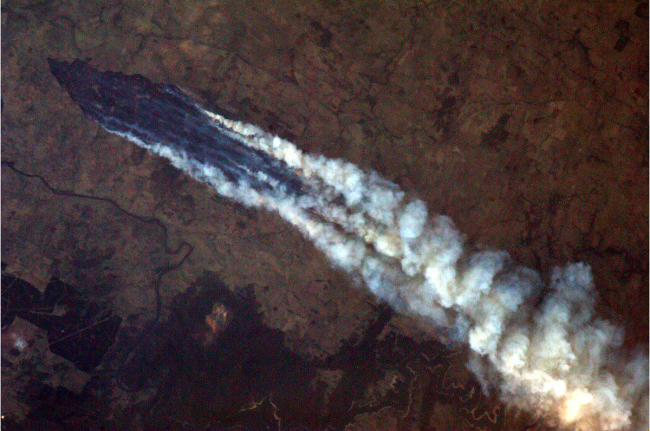YASS, Australia (AFP) ― Australian firefighters raced to control a series of blazes Thursday before a forecast rise in temperatures brings the risk of more infernos, as dramatic accounts of survival emerged.
Fires have been raging across southeast Australia for nearly a week. While many have been contained, 120 are still burning and at least 17 remain out of control in the country’s most populous state, New South Wales.
Cooler weather that brought some relief on Wednesday continued in many parts Thursday. But temperatures are set to soar again to well over 40 degrees Celsius on Friday, piling pressure on firefighters.
 |
This photo, taken by astronaut Chris Hadfield from the International Space Station, shows a view of the wildfires in Australia. (AP-Yonhap News) |
In Tasmania residents of the fishing village of Dunalley, where 90 homes and businesses were destroyed, could be allowed to go home Friday, police said, as gripping stories of survival emerged.
“We saw tornadoes of fire just coming across towards us and the next thing we knew everything was on fire, everywhere all around us,” Tim Holmes, who took refuge in the sea under a jetty with his five young grandchildren, told the ABC.
“We were all just heads, water up to our chins just trying to breathe because ... the atmosphere was so incredibly toxic.”
The family survived but are now homeless.
NSW Rural Fire Service commissioner Shane Fitzsimmons said crews were working flat-out containing blazes before the heat returned.
“It’s about focusing on getting as much contained and consolidated as we can ahead of a return to hotter and dryer conditions dominating much of NSW over the coming days,” Fitzsimmons told ABC television.
“We’re looking at temperatures across much of NSW into low-to-mid 40s and extending into the high 40s on Saturday.
“The only reprieve, if you can call it that, is that we are not expecting significant wind strengths to build.”
The blazes have scorched more than 350,000 hectares of land in New South Wales alone, with one fire burning just two kilometers from a former weapons range littered with unexploded bombs.
The 5,840-hectare Deans Gap fire is near the Tianjara plateau which, until the mid-1970s, was used by the army as a practice bombing range.
“If it was required they’d be looking to put in a firebreak in that area,” a New South Wales Rural Fire Service spokeswoman said.





![[Exclusive] Hyundai Mobis eyes closer ties with BYD](http://res.heraldm.com/phpwas/restmb_idxmake.php?idx=644&simg=/content/image/2024/11/25/20241125050044_0.jpg)
![[Herald Review] 'Gangnam B-Side' combines social realism with masterful suspense, performance](http://res.heraldm.com/phpwas/restmb_idxmake.php?idx=644&simg=/content/image/2024/11/25/20241125050072_0.jpg)

